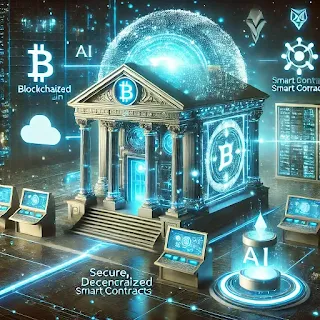How Blockchain and AI Are Merging to Revolutionize Industries
Introduction
Blockchain and Artificial Intelligence (AI) are two of the most disruptive technologies of the 21st century. AI specializes in data processing, automation, and decision-making, while blockchain ensures security, transparency, and decentralization.
The integration of these two technologies is reshaping industries like finance, healthcare, cybersecurity, and supply chain management. AI enhances blockchain’s efficiency, while blockchain makes AI more reliable by ensuring tamper-proof data storage.
How AI and Blockchain Work Together
1. Decentralized AI Systems
Traditional AI systems are controlled by big tech companies like Google, Amazon, and Microsoft. This raises concerns about data privacy and monopolization. By integrating AI with blockchain, we can create decentralized AI systems, where no single entity has control over data.
2. AI-Enhanced Smart Contracts
Blockchain-based smart contracts automate agreements without human intervention. AI improves these contracts by enabling them to analyze real-time data before execution. For example, an AI-powered insurance contract could automatically process claims based on verified blockchain data.
3. Data Security & Fraud Prevention
AI relies on vast amounts of data to make accurate predictions. Blockchain ensures that this data is tamper-proof and free from manipulation. This combination is particularly useful in financial transactions, identity verification, and cybersecurity.
Industries Benefiting from AI + Blockchain
1. Finance & Banking
- Fraud detection: AI analyzes transaction patterns, while blockchain ensures data integrity.
- Automated trading: AI-powered trading bots use blockchain for transparent transaction records.
- Digital identity verification: Blockchain-backed AI prevents identity theft in banking systems.
2. Healthcare
- AI-assisted diagnostics: AI detects diseases early, while blockchain ensures secure medical records.
- Clinical trials & drug development: Blockchain prevents manipulation of trial data, improving AI-driven medical research.
- Remote patient monitoring: AI tracks patient health, while blockchain stores medical history securely.
3. Supply Chain Management
- Transparency: Blockchain ensures every product's journey is trackable.
- Demand forecasting: AI predicts shortages or excess supply using real-time blockchain data.
- Product authentication: AI detects counterfeit products, and blockchain verifies authenticity.
Challenges of AI & Blockchain Integration
1. Scalability Issues
Blockchain networks, such as Ethereum and Bitcoin, are slower compared to centralized systems. AI requires high-speed data processing, which blockchain sometimes cannot provide efficiently.
2. Regulatory Uncertainty
Many governments are still defining legal frameworks for AI and blockchain. Issues like data ownership, compliance, and ethical AI use remain unresolved.
3. Energy Consumption
Both AI and blockchain require high computing power, leading to high energy consumption. Researchers are working on eco-friendly solutions like proof-of-stake blockchain models and energy-efficient AI algorithms.
The Future of AI and Blockchain
1. AI-Powered DAOs (Decentralized Autonomous Organizations)
DAOs are organizations run by smart contracts without human intervention. With AI integration, these organizations will make intelligent decisions based on real-time data, revolutionizing governance and business models.
2. AI & Blockchain in Cybersecurity
- AI-driven threat detection combined with blockchain’s immutable records will prevent cyberattacks.
- Blockchain will ensure secure AI model training by preventing data poisoning attacks.
3. AI-Generated Blockchain Data
AI can automate blockchain data validation, analytics, and prediction models, making blockchain networks more efficient.
Conclusions
AI and blockchain together will transform industries by ensuring automation, security, transparency, and efficiency. Despite challenges like scalability and regulations, their future potential is limitless. Businesses that adopt this combination early will have a competitive advantage in the digital economy.











0 Comments